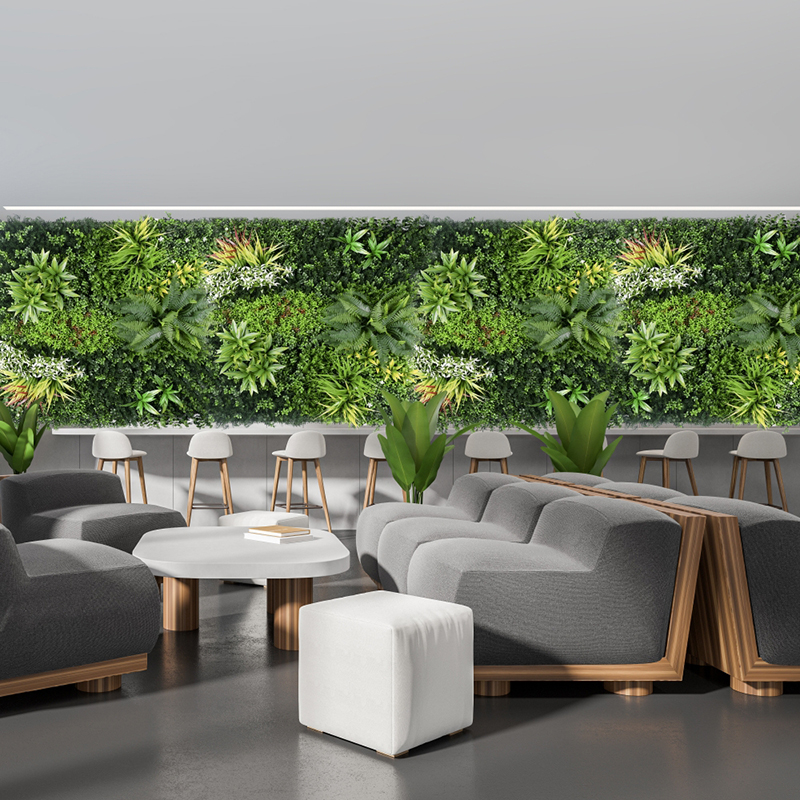Moss Application Techniques for 3D Artificial Vertical Gardens: Enhancing Aesthetics and Sustainability
Moss is a versatile, low-maintenance option for adding natural texture and ecological benefits to 3D artificial vertical gardens. Unlike live plants, artificial moss requires no watering, sunlight, or soil, making it ideal for indoor or shaded outdoor spaces. Below are expert techniques to maximize its visual appeal and longevity in vertical installations.

Not all artificial moss varieties perform equally in vertical gardens. Factors like texture, density, and color stability determine how well they integrate into 3D structures.
Reindeer Moss Alternatives: While real reindeer moss thrives in humid environments, synthetic versions mimic its fluffy, sponge-like texture. Opt for UV-stabilized options to prevent fading in sunlight, ensuring vibrant green hues year-round.
Sheet Moss Simulations: Artificial sheet moss offers a flat, carpet-like appearance that works well for covering large, uniform areas. Choose materials with embedded fibers to create depth and mimic the layered growth of natural moss.
Mixed-Texture Blends: Combining different moss types—such as clumping varieties with fine, feathery strands—adds visual interest. This approach works particularly well in 3D gardens with varying panel depths or contours.
Proper installation ensures artificial moss stays in place while allowing airflow to prevent moisture buildup, which could degrade materials over time.
Non-Toxic Adhesive Backing: Many artificial moss panels come with pre-applied adhesive strips or glue dots. For custom installations, use a waterproof, eco-friendly adhesive designed for outdoor use to avoid chemical runoff.
Mechanical Fastening Systems: In high-traffic or wind-exposed areas, secure moss panels with stainless-steel clips or hidden screws. This method is especially effective for 3D gardens with overlapping or interlocking components.
Drainage-Friendly Layering: Leave small gaps between moss sections to promote air circulation. If using a solid backing, drill tiny holes to prevent water retention, which could lead to mold growth on synthetic materials.
Artificial moss can look flat or artificial if not carefully designed. Strategic use of color gradients and texture contrasts creates a lifelike appearance.
Subtle Color Blending: Mix shades of green, yellow, and brown to replicate the natural aging process of moss. Avoid uniform blocks of color by hand-painting edges or using multi-toned panels.
3D Layering Techniques: Attach smaller moss clumps to raised sections of the vertical garden to create depth. This mimics how moss grows in clusters on uneven surfaces like tree bark or rocks.
Integrating Natural Elements: Combine artificial moss with preserved twigs, bark, or stones to add organic complexity. These accents break up monotony and enhance the garden’s connection to its environment.
While artificial moss requires minimal upkeep, occasional cleaning and adjustments keep it looking fresh and prevent material degradation.
Dust Removal Strategies: Use a soft-bristle brush or compressed air to gently remove dust from moss surfaces. Avoid wet cleaning methods, as moisture can weaken adhesive bonds or cause synthetic fibers to clump.
UV Protection Measures: In sunny locations, apply a non-toxic UV-resistant coating to artificial moss panels every 1–2 years. This prevents color fading and maintains the material’s structural integrity.
Inspecting for Wear: Check for loose edges or peeling adhesive, especially in high-traffic areas. Re-secure panels with additional glue or clips to prevent wind damage or accidental detachment.
By focusing on material selection, secure installation, realistic design, and proactive maintenance, artificial moss can transform 3D vertical gardens into dynamic, eco-friendly focal points. Its adaptability makes it a valuable tool for architects and designers seeking to blend nature with modern aesthetics.
Contact: Amy
Phone: 86-15311787313
E-mail: info@foszmac.com
Whatsapp:86-15311787313
Add: Fengtai District, Dacheng Road, No.24 Building, Room 203, Beijing, China